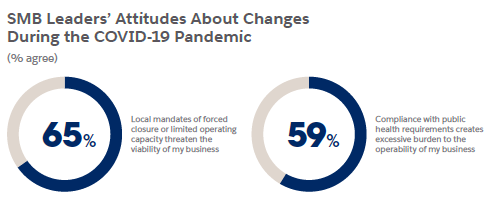SME trends not only shine a light on the current business landscape, they show us what tomorrow might look like – and how SMEs can best prepare for it. Last year was an especially transformative one for Small and Medium Bussinesses (SMEs) in the UK, as disruptions, closures, safety concerns and changing customer expectations launched us into an unpredictable world. Some SMEs have been able to evolve and thrive in the face of change, while others have been left in the shadows of shuttered shops, empty offices and ghostly town centres.
To find out how some businesses are growing, why some are stagnating, and what’s driving SME trends during these challenging times, Salesforce partnered with The Harris Poll to gather insights from over 2,300 SME owners and leaders from around the world. The results have been compiled in the 4th edition of the SME Trends Report – and if you scratch beneath the surface there’s plenty of reason for hope.
SMEs are fighting for a better future
The new business climate has presented a number of challenges for UK SMEs, who have had to address increasing customer expectations, the closure of shops, the move to remote working, and the prioritisation of employee and customer safety. Issues that weren’t on the radar for SMEs just ten months ago have forced many into a fight for survival.
According to our SME Trends Report, 65% of SME leadersglobally say that local mandates of forced closure or limited operational capacity threaten the viability of their business, and 59% say that compliance with health requirements creates excessive burden to the operability of their business. SMEs need to offset these concerns and create a safe workplace before shifting their focus towards other challenges, of which there are plenty.

It’s no surprise, then, that more than half (57%) of SME leaders say that they’re struggling to keep their business afloat. Industries and sectors more likely to share this sentiment include consumer products (69%), retail (67%), and hospitality/travel/transportation (67%). Many SMEs in these industries have seen business come to a complete standstill, and now have to deal with capital issues on top of restrictions and new ways of working.
What is surprising is that despite all the disruptions and unforeseeable challenges, SME owners remain resolutely optimistic in the face of adversity. In fact, for many, tomorrow looks brighter than ever.
Today’s SME trends are fuelled by optimism
With nearly 60% of SME leaders saying that they're struggling to keep their business afloat, it would be easy to curl up and quit, but today’s SME leaders remain hopeful. Figures show that while 80% of SMEs were optimistic about their future in March last year; that number was at 72% in August – well after the pandemic disrupted the business landscape. In fact, the percentage of leaders who are ‘not optimistic at all’ only moved from 4% in March to 5% in August, showing that businesses aren’t about to just throw in the towel.

Many businesses are using this as an opportunity to transform and grow stronger. SME leaders in the healthcare (83%), technology (81%) and consumer product (77%) industries have especially rosy outlooks about their future, perhaps because they’re not only building resilience in those industries, they’re creating experiences that turn crisis into opportunity. The digital imperative was here before COVID-19 was, but it’s certainly been accelerated, and digital transformation for small businesses offers a roadmap for successful evolution: don’t just endure – thrive.
Hope goes digital: where SME trends are headed
Navigating crisis can be difficult, especially for SMEs that operate in sectors that have been heavily disrupted by the pandemic and aren't digitally mature. Not all SMEs have the time to create a digital transformation strategy, or the workforce needed to pivot to completely new modes of service. And it is true that while digitalisation can vastly benefit businesses, it may not mean total salvation for some of the harder hit industries at the moment. But ingenuity and imagination go a long way, and digital transformation for small businesses is the great equaliser.
Here are a few ways that businesses are transforming in the face of crisis:
- Asia’s platform economy has enabled many businesses to evolve. Rakuten launched a takeout app that allowed restaurants to continue service after their physical locations shut, effectively functioning as ghost kitchens. Meanwhile, Hydrogen Craft Corporation pivoted from making drones to making carts to disinfect airports and train stations.
- Virtual correspondence has come to the fore, with video conferencing services operating as the new-norm. In the UK, software copany AccuRx helped the NHS pivot to a virtual-driven service, through consultations over video, online document submission facilities & patient remote monitoring.
- Korea Seven launched AI-powered, employee-free stores in Seoul, which some believe will usher in a new culture of contactless automation.
- Many hotels began offering completely contact-free experiences, with digital check-in/checkout, keys and automated follow-up emails.
- Fashion brands like Michael Kors introduced exciting new digital experiences, while high-end Dutch lingerie brand marlies dekkers launched a virtual swimwear fitting room, and Welden had a virtual runway show. Other retailers went further, tasking in-store staff with fulfilling online orders, or even retraining them to function as online personal stylists or virtual concierges.
- Forward-thinking brands leveraged AR and VR to bring real-world experiences to customers who found themselves isolated during lockdown measures. Some humanitarian organisations even turned to VR to put users in the middle of war-torn regions – letting them walk a mile in someone else’s shoes. These kind of empathy-building experiences and tech-enabled learning journeys will only become more popular.
Digital transformation for small businesses: the next chapter starts now
It’s evident that the problems are real for SMEs – but so are the solutions. COVID-19 has knocked us back, but not for good. After all, it’s not how many times you fall that matters; it’s how many times you get back up. Digital transformation for small businesses can help SMEs pull themselves off the mat – stronger, faster and better than ever before.
To see more insights from SME owners around the world, download the 4th edition of the SME Trends Report today.








